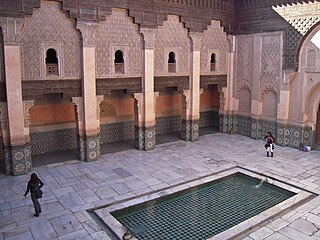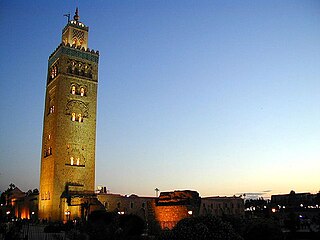
The Ben Youssef Madrasa is an Islamic madrasa (college) in Marrakesh, Morocco. Functioning today as a historical site, the Ben Youssef Madrasa was the largest Islamic college in the Maghreb at its height. The madrasa is named after the adjacent Ben Youssef Mosque built by the Almoravid Sultan Ali ibn Yusuf in the early 12th century, and was commissioned by the Saadian Sultan Abdallah al-Ghalib in the 16th century.

The Saadian Tombs are a historic royal necropolis in Marrakesh, Morocco, located on the south side of the Kasbah Mosque, inside the royal kasbah (citadel) district of the city. They date to the time of the Saadian dynasty and in particular to the reign of Ahmad al-Mansur (1578–1603), though members of Morocco's monarchy continued to be buried here for a time afterwards. The complex is regarded by many art historians as the high point of Moroccan architecture in the Saadian period due to its luxurious decoration and careful interior design. Today the site is a major tourist attraction in Marrakesh.

Abdallah al-Ghalib Billah was the second Saadian sultan of Morocco. He succeeded his father Mohammed al-Shaykh as Sultan of Morocco.

The Shrob ou Shouf Fountain or Chrob ou Chouf Fountain is a historic wall fountain in the medina of Marrakech, Morocco. It dates from the late 16th or early 17th century and is located near the Ben Youssef Madrasa.

This article describes notable landmarks and architecture in the city of Marrakesh, Morocco.

The Ben Youssef Mosque, is a mosque in the Medina quarter of Marrakesh, Morocco, named after the Almoravid emir Ali ibn Yusuf. It is arguably the oldest and most important mosque in Marrakesh.

Mouassine is a district within the Medina of Marrakech neighbouring the districts of Bab Doukkala, Azbezt, Derb Tizougarine and Riad Aitoun El Kedim. The area contains the Mouassine Mosque, the Mouassine Fountain, and the Dar el Bacha Palace.

The Kasbah Mosque is a historic mosque in Marrakesh, Morocco. It was originally built by the Almohad ruler Yaqub al-Mansur in 1185-1190 CE. It is located in the Kasbah district, the city's former citadel, near the site of its historic royal palaces. Along with the Kutubiyya Mosque, it is one of the most important historic mosques in Marrakesh.

The Bab Doukkala Mosque or Mosque of Bab Doukkala is a major neighbourhood mosque in Marrakesh, Morocco, dating from the 16th century. It is named after the nearby city gate, Bab Doukkala, in the western city walls. It is also known as the al-Hurra Mosque.

The Mouassine Mosque or al-Muwassin Mosque is a major neighbourhood mosque in Marrakech, Morocco, dating from the 16th century during the Saadian dynasty. It shares its name with the Mouassine neighbourhood.

The Zawiya of Sidi Abd el-Aziz is an Islamic religious complex (zawiya) in Marrakesh, Morocco. It is centered around the tomb of the Muslim scholar and Sufi saint Sidi Abu Faris Abd al-Aziz Abd al-Haq at-Tabba', who died in Marrakesh in 1508. Sidi Abd el-Aziz is considered one of the Seven Saints of Marrakesh, and his tomb was a prominent stop for pilgrims to Marrakesh. The zawiya is located on Rue Mouassine at its intersection with Rue Amesfah.

The Zawiya of Sidi Muhammad Ben Sliman al-Jazuli is an Islamic religious complex (zawiya) in Marrakesh, Morocco. It is centered around the tomb of the 15th-century Muslim scholar and Sufi saint Muhammad al-Jazuli, who is one of the Seven Saints of Marrakesh.

The Kasbah of Marrakesh is a large walled district in the southern part of the medina of Marrakesh, Morocco, which historically served as the citadel (kasbah) and royal palace complex of the city. A large part of the district is still occupied by the official royal palace, the Dar al-Makhzen, which serves as the residence of the King of Morocco when he visits the city. The rest of the district consists of various neighbourhoods and monuments. It was founded by the Almohads in the late 12th century, with most of the construction carried out by Caliph Ya'qub al-Mansur. Two of its most important surviving structures today, the Kasbah Mosque and the main gate of Bab Agnaou, date from al-Mansur's reign.

The Zawiya of Sidi Bel Abbes or Zaouia of Sidi Bel-Abbès is an Islamic religious complex (zawiya) in Marrakesh, Morocco. The complex is centered around the mausoleum of Abu al-Abbas as-Sabti, a Sufi teacher who died in 1204. He is the most venerated of the Seven Saints of Marrakesh, generally considered the "patron saint" of the city. The zawiya's architecture dates in part to the late Saadian period but has been modified and restored multiple times since then.

Sidi Yusuf ibn 'Ali as-Sanhaji is a wali who was born in Marrakesh, Morocco and died there in 1196 CE. He is considered one of the Seven Saints of Marrakesh, and one of the administrative divisions of Marrakesh is named after him.

The Mouassine Museum is a museum in the Mouassine neighbourhood of the historic medina of Marrakesh, Morocco. The museum is housed in a recently restored 16th to 17th-century house which includes an upper-floor apartment known as a douiria. It was recently converted to a Museum of Music, with permanent and temporary exhibits.

The Mausoleum of Moulay Isma'il is a historic Islamic funerary complex in Meknes, Morocco. It contains the tomb of Sultan Moulay Isma'il, who ruled Morocco from 1672 until his death in 1727, and is located inside his former Kasbah (citadel). It is a major historic and religious site in the city.
Abdallah al-Ghalib II was a member of the Saadian dynasty who ruled parts of Morocco during the succession conflicts within the dynasty between 1603 and 1627. He was the son of Muhammad al-Sheikh al-Ma'mun, who was in turn the son of the powerful sultan Ahmad al-Mansur. He ruled in Marrakesh from 1606 to 1609 and ruled in Fes from 1609 to 1613.

The Mouassine Fountain is a part of the 16th-century religious complex of the Mouassine Mosque in Marrakesh, Morocco. The tradition of building public fountains in Marrakesh is old but took on a very monumental character in the Saadian era.

Traditional houses in Morocco are usually centered around a large internal courtyard, the wast ad-dar, and are characterized by a focus on interior decoration rather than on external appearance. The houses of wealthy residents featured decoration typical of Moroccan architecture and medieval Moorish architecture, including carved and painted wood, carved stucco, and zellij. The center of larger houses could also be occupied by a riad garden, particularly in places like Marrakesh where more space was available.





















